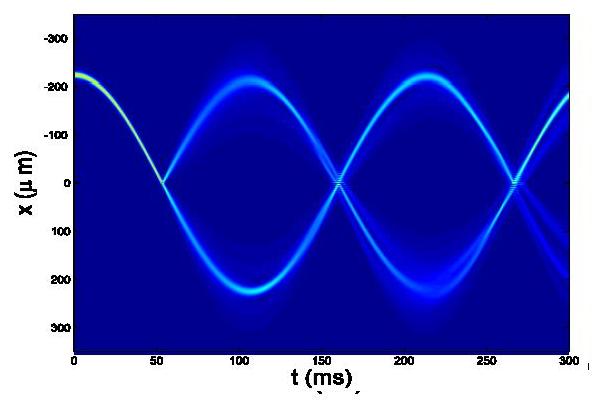

Author: J Cuevas
With RG Hulet, D Dries, S Pollack, BA
Malomed and PG Kevrekidis

An important application of Bose-Einstein condensates is the use of matter waves for interferometry, which may feature superb accuracy, in comparison with optical schemes [1]. This work aims to build an interferometer based on bright matter-wave solitons, and develop a theoretical model of the device. A prototype is built as a one-dimensional trap with a weak parabolic potential acting along its axis (with strength ~ 5 Hz, while the strength of the transverse confinement is ~ 250 Hz), and a narrow potential barrier (with width ~ 3-5 μm and height ranging between 300 Hz and 3 KHz) induced by a laser beam close to the central point. A soliton is created and released at a distance of few hundred microns from the center, which implies that it will strike the barrier with a kinetic energy of up to 700 Hz. The number of 7Li atoms in the setting is between 5000 and 10000. It is observed that, upon hitting the barrier, the soliton, whose width is ~ 10 μm, may split into two parts, reflected and one transmitted ones. After the completion of half a cycle of oscillations in the axial trap, the secondary solitons collide again. Tuning the parameters, it is possible to implement their nearly ideal recombination, after one or two collisions, into a soliton resembling the original one. Theoretical considerations predict that the recombined soliton may exit in either direction (see an example of simulations in Fig. 1), which is indeed observed in the experiment. In particular, the exit direction of the recombined soliton, as well as the degree of the completeness of the recombination, can be controlled by a shift of the splitting barrier from the central point. The extension of the experiment and theoretical analysis will be carried out with an "object" (at first, an obstacle created by a detuned laser beam) placed into one arm of the interferometer, with the aim to extract information about the object from the change of the recombination picture, due to a phase shift of the secondary soliton passing the obstacle. The same setting may be used for the creation and investigation of quantum "Schrödinger-cat" states, via splitting and recombination of coherent quantum wave packets of nonlinear matter waves.
References:
[1] C. Gross, T. Zibold, E. Nicklas, J. Est& Ève,
and M. K. Oberthaler, Nature 464, 1165 (2010).
41th
Winter Colloquium on Quantum Electronics, Snowbird, Utah (US), January 3-6, 2011. Talk by BA Malomed.